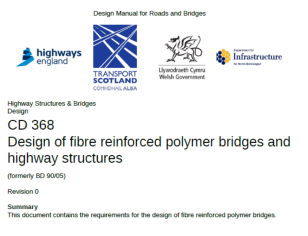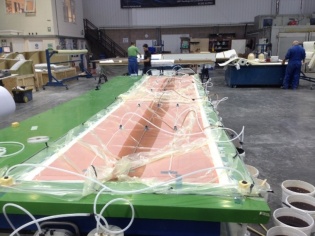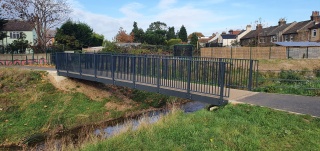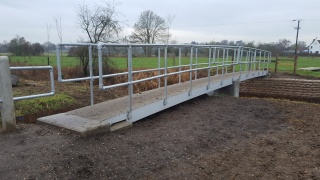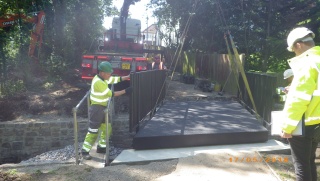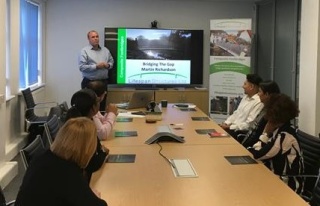Articles tagged “Timber Footbridge”
Lifespan Structures - Design Service
/ Martin Richardson / CD368, CD368, Composite, Composites UK, CUR96, CUR96, FRP Composites, Pedestrian, Timber Footbridge
Information on the design of FRP footbridges has developed quickly over the last few years, with the new version of the DMRB which included the publication of CD368 - Design of fibre reinforced polymer bridges and highway structures, and the updates to recommendations in Europe such as CROW-CUR recommendation 96-2019 Fibre-reinforced polymers in buildings and civil engineering structures (CUR96)
Whilst CD368 is now very much in line with CUR96, there are still some fundamental differences between the 2 documents.
Composite Bridges - A comparison between moulded and pultruded bridges.
/ Martin Richardson / CD368, Composite, Composite, CUR96, FRP Composites, FRP Composites, Lightweight, Pedestrian, Timber Footbridge
We have published a technical paper to help clients and specifiers understand the significant differences in terms of installation, performance and long term maintenance of the different types of FRP bridge solutions that are available. There are two generic types of FRP composite bridges and they have quite different performance characteristics and maintenance requirements, so it is important for clients to understand the differences at the procurement stage. Moulded bridge decks are generally manufactured in a mould with dry fibres laid in specific orientations with a core material to produce a sandwich construction.
Case Study - Albany Park Footbridges
/ Martin Richardson / CD368, CUR96, Cycleway, Footbridge, Footbridge, FRP Composites, Lightweight, Lightweight, Timber Footbridge
DESCRIPTION
The Client had already purchased 4 moulded FRP composite footbridges from Lifespan Structures since 2018 recognising that for a similar purchase price to a steel bridge the Lifespan bridge significantly reduces installation costs and future maintenance costs. For Albany Park Lifespan designed and delivered 2No. bridges each 12m long. One bridge was a pedestrian bridge 2m wide and the other one was for pedestrians and service vehicles 2.5m wide. Each bridge had galvanised steel, powder coated bespoke parapets to the Client’s design.
PROW Benefits from new 2 span FRP Footbridge
/ Martin Richardson / Bridleway, CUR96, Footbridge, Footpath, FRP Composites, FRP Composites, Lightweight, Pedestrian, Pedestrian, PROW, PROW, Timber Footbridge
This Public Rights of Way (PROW), 2 span bridge was installed in December 2018. The lightweight nature allowed easy installation in this remote location during the winter months and moulded deck technology means long term maintenance will be reduced to a minimum. The total length of the bridge was 14m and 0.905m wide between the handrails. The handrails were attached to the outside edge of the bridge to minimise the overall width of the structure to suit site constraints. The project demonstrates that FRP bridges can be a cost effective, durable alternative to traditional construction methods for small remote structures.
Hounsden Gutter Project Completed
/ Martin Richardson / BD90/05, BD90/05, Carbon Fibre, Composite, Composite, CUR96, CUR96, Cycleway, Footbridge, Footbridge, FRP Composites, FRP Composites, Pedestrian, Timber Footbridge, Uncategorized
The existing skewed reinforced concrete footbridge had come to the end of it life, so an FRP Replacement was selected to provide reduced maintenance in the tree enclosed environment over the Gutter. Following completion of new abutments and associated retaining walls, the lightweight, preformed, replacement allowed fast and simple installation on site using a lorry mounted crane, to both transport and lift the bridge into place. The colour scheme was selected to match the clients requirements.
FRP Bridge at Sedlescombe - Over 3 years old.
/ Martin Richardson / BD90/05, BD90/05, Carbon Fibre, Composites UK, CUR96, Footbridge, Footbridge, Footpath, FRP Composites, FRP Composites, Lightweight, Pedestrian, Pedestrian, Timber Footbridge, Timber Footbridge, Wooden Footbridge
600kg FRP bridge deck replaces a 2-3000kg timber bridge, delivered and put in place in just a few hours. The installation of our first generation of lightweight footbridge structures is over 3 years ago now.
FRP Footbridge Durability Utilised in Damp Environment
/ Martin Richardson / BD90/05, BD90/05, Composite, Composite, CUR96, CUR96, Cycleway, Fibercore, Footbridge, Footbridge, FRP Composites, FRP Composites, Lightweight, Pedestrian, Pedestrian, Timber Footbridge, Timber Footbridge, Wooden Footbridge
A small bridge, just 5m span, used to gain public access across a drainage ditch into a local nature reserve. The client was concerned that a traditional timber structure would have reduced durability due to damp environment, so selected the FRP option to reduce maintenance and subsequent whole life cost. Its very well used by a lot of happy, wet and very muddy dogs!
Bridging the Gap - CPD Presentation
/ Martin Richardson / BD90/05, BD90/05, Bridleway, Bridleway, Carbon Fibre, Composite, Composite, Composites UK, Composites UK, CUR96, CUR96, Cycleway, Fibercore, Fibercore, Footbridge, Footbridge, Footpath, FRP Composites, FRP Composites, Lightweight, Lightweight, Pedestrian, Pedestrian, Rural, Steel Footbridge, Steel Footbridge, Timber Footbridge, Timber Footbridge, Wooden Footbridge, Wooden Footbridge
We are currently offering our CPD presentation called 'Bridging the Gap', if this is of interest please get in touch. The presentation is particularly suited to local authority bridge engineers and consulting engineers who provide bridge services. The presentation will covers the following topics to introduce the concept of using FRP materials rather than steel, timber and concrete. - Introduction to FRP composites
- History of FRP composites in construction
- Recent case studies
- Benefits
- Cost comparisons with traditional materials
- Environmental benefits
This presentation will inform attendees of the significant benefits so that the FRP composite material option can be included in appropriate future proposals for the benefit of clients.

